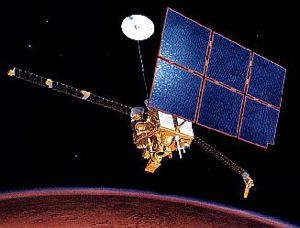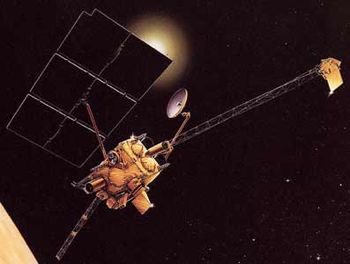
Home - Search - Browse - Alphabetic Index: 0- 1- 2- 3- 4- 5- 6- 7- 8- 9
A- B- C- D- E- F- G- H- I- J- K- L- M- N- O- P- Q- R- S- T- U- V- W- X- Y- Z
Mars Observer
 Mars observor Credit: NASA |
Status: Operational 1992. First Launch: 1992-09-25. Last Launch: 1992-09-25. Number: 1 . Gross mass: 2,573 kg (5,672 lb). Height: 3.20 m (10.40 ft).
The mission was designed to operate for one full Martian year (687 Earth days) to permit observations of the planet through its four seasons.
The mission specific objectives were to (1) determine the global elemental and mineralogical character of Mars' surface material, (2) define the planet's global topography and gravitational field, (3) establish the nature of the Martian magnetic field, (4) determine the time and space distribution, abundance, sources and sinks of volatile material and dust over a seasonal cycle, (5) explore the structure and aspects of the circulation of the Martian atmosphere. The spacecraft also carried a radio relay package designed to receive information from the planned Mars Balloon Experiment carried on the planned Soviet Mars '94 mission for retransmission back to Earth. Communications was lost with the spacecraft on 22 August 1993 as it was preparing to go into orbit around Mars, and no significant scientific data was returned. Later investigation indicated this was due to a propulsion system explosion caused by propellants leaking past faulty valves.
The spacecraft was based on Earth-orbiting spacecraft (DMSP and TIROS) and was 3-axis stabilized, zero momentum bias using reaction wheels. Communications with Earth used an X-band system and 1.5 m articulated high gain antenna mounted on a 6-meter boom. The deployed 3.7 x 6.5 meter solar array generated 1.1 - 1.5 kW. The hydrazine and bi-propellant propulsion systems performed trajectory maneuvers, Mars orbit capture and circularization, and orbit maintenance. Deployable booms provided mounting points for instruments. The payloads included:
- Gamma-ray spectrometer (GRS) - designed to measure the abundance of elements (uranium, thorium, potassium, iron and silicon, for example) on the surface of Mars.
- Thermal-emission spectrometer (TES) - intended to map the mineral content of surface rocks, frosts and the composition of clouds.
- Mars Observer Camera (MOC) - a line-scan camera designed to take low-resolution images of Mars on a daily basis for studies of the climate, and medium- and high-resolution images of selected areas to study surface geology and interactions between the surface and the atmosphere. Laser altimeter - intended to measure the topographic relief of the Martian surface.
- Pressure-modulator infrared radiometer (PMIRR) - designed to measure dust and condensates in the atmosphere, as well as profiles of temperature, water vapor and dust opacity as they change with latitude, longitude and season.
- Radio-science investigation - planned to use the spacecraft radio with an ultrastable oscillator to measure atmospheric refractivity as it varies with altitude to determine the temperature profile of the atmosphere, and would use tracking data to measure the gravity field of Mars.
- Magnetometer and electron reflectometer - designed to determine the nature of the magnetic field of Mars, and its interactions with the solar wind.
NASA NSSDC Master Catalog Description
Mars Observer, the first of the Observer series of planetary missions, was designed to study the geoscience and climate of Mars. The primary science objectives for the mission were to: (1) determine the global elemental and mineralogical character of the surface material; (2) define globally the topography and gravitational field; (3) establish the nature of the Martian magnetic field; (4) determine the temporal and spatial distribution, abundance, sources, and sinks of volatiles and dust over a seasonal cycle; and, (5) explore the structure and circulation of the atmosphere.
The bus and electronics of the Observer series of spacecraft, used to study the terrestrial planets and near-Earth asteroids, were derived from the Satcom-K and DMSP/TIROS spacecraft. The rectangular bus section was 2.1 x 1.5 x 1.1 m. During the cruise phase of the mission, the high-gain antenna and the booms for the magnetometer (MAG/ER) and gamma-ray spectrometer (GRS) were partially deployed. When fully deployed, the two booms were each 6 m long. The 1.5 m diameter high-gain antenna was, when fully deployed, on a 5.5 m boom to allow for clearance over the solar array when the antenna was pointed toward Earth.
Pointing control for the spacecraft was maintained through the use of four reaction wheels. Attitude information was provided by a horizon sensor (which defined the direction of the nadir), a star mapper (for inertial attitude), gyros and accelerometers (for measuring angular rates and linear accelerations), and multiple Sun sensors. Power was provided through a six-panel solar array which, when fully deployed, measured 7.0 x 3.7 m. During the cruise phase, however, only four panels were deployed (due to the proximity of the spacecraft to the sun) to reduce the amount of power generated. During periods when the spacecraft was in Mars' shadow, energy was to be provided by two Ni-Cd batteries, each with a capacity of 43 amp-hours.
The interplanetary cruise phase of the mission was intended primarily for spacecraft and instrument checkout and calibration. Two periods of data collection for the MAG/ER and GRS and one for the gravity wave experiment were planned for this phase as well. During the four month period from Mars orbital insertion until the spacecraft was to achieve its final mapping orbit, only data collection for the MAG/ER, GRS, and thermal emission spectrometer (TES) were scheduled. The mapping phase of the mission was scheduled to nominally last one Martian year. Mars Observer was also to support the acquisition of data from the Russian Mars 1994 mission through the use of the joint French-Russian-American Mars Balloon Relay instrument.
Contact with Mars Observer was lost on August 21, 1993, three days before scheduled orbit insertion, for unknown reasons and has not been re-established. It is not known whether the spacecraft was able to follow its automatic programming and go into Mars orbit or if it flew by Mars and is now in a heliocentric orbit. Later investigation concluded the most probable cause of the mishap was a fuel line rupture during fuel tank pressurization which would have caused the spacecraft to spin uncontrollably. Although none of the primary objectives of the mission were achieved, cruise mode data were collected up to loss of contact. The total cost of the Mars Observer mission including development, construction, launch, and ground support is estimated at $813 million.
More at: Mars Observer.
Family: Mars orbiter. Country: USA. Engines: R-4D. Launch Vehicles: Titan, Mars tactical rocket, Commercial Titan 3. Projects: Mars. Launch Sites: Cape Canaveral, Cape Canaveral LC40. Agency: JPL, NASA, Astro Space. Bibliography: 2, 279, 6, 6685, 12807.
 | Mars Observer Credit: Manufacturer Image |
1992 September 25 - . 17:05 GMT - . Launch Site: Cape Canaveral. Launch Complex: Cape Canaveral LC40. LV Family: Titan. Launch Vehicle: Commercial Titan 3.
- Mars Observer - . Payload: Mars Observer [TOS-21H]. Mass: 2,573 kg (5,672 lb). Nation: USA. Agency: JPL. Class: Mars. Type: Mars probe. Spacecraft: Mars Observer. USAF Sat Cat: 22136 . COSPAR: 1992-063A. Planned Mars orbiter; lost contact during orbit insertion burn. Solar Orbit (Heliocentric). Spacecraft engaged in research and exploration of the upper atmosphere or outer space (US Cat B)..
1993 August 22 - .
- Communications lost with Mars observor - .
Nation: USA.
Spacecraft: Mars Observer.
Communications was lost with the spacecraft on August 22, 1993 as it was preparing to go into orbit around Mars, and no significant scientific data was returned. Later investigation indicated this was due to a propulsion system explosion caused by propellants leaking past faulty valves.
Back to top of page
Home - Search - Browse - Alphabetic Index: 0- 1- 2- 3- 4- 5- 6- 7- 8- 9
A- B- C- D- E- F- G- H- I- J- K- L- M- N- O- P- Q- R- S- T- U- V- W- X- Y- Z
© 1997-2019 Mark Wade - Contact
© / Conditions for Use